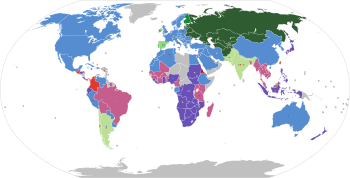3 ft gauge railways
Three foot gauge railways have a track gauge of 3 ft (914 mm) or 1 yard. This gauge is a narrow gauge and is generally found throughout North, Central, and South America. In Ireland, many secondary and industrial lines were built to 3 ft gauge, and it is the dominant gauge on the Isle of Man, where it is known as the Manx Standard Gauge. Modern 3 ft gauge railways are most commonly found in isolated mountainous areas, on small islands, or in large-scale amusement parks and theme parks (see table below). This gauge is also popular in model railroading (particularly in G scale), and model prototypes of these railways have been made by several model train brands around the world, such as Accucraft Trains (US), Aristo-Craft Trains (US), Bachmann Industries (Hong Kong), Delton Locomotive Works (US), LGB (Germany),[1] and PIKO (Germany).
| Track gauge | ||||||||||||||||||||||||||||||||||||||||||||||||||||||||||||||||||||||||||||||||||||||||
|---|---|---|---|---|---|---|---|---|---|---|---|---|---|---|---|---|---|---|---|---|---|---|---|---|---|---|---|---|---|---|---|---|---|---|---|---|---|---|---|---|---|---|---|---|---|---|---|---|---|---|---|---|---|---|---|---|---|---|---|---|---|---|---|---|---|---|---|---|---|---|---|---|---|---|---|---|---|---|---|---|---|---|---|---|---|---|---|---|
| By transport mode | ||||||||||||||||||||||||||||||||||||||||||||||||||||||||||||||||||||||||||||||||||||||||
|
Tram · Rapid transit Miniature · Scale model |
||||||||||||||||||||||||||||||||||||||||||||||||||||||||||||||||||||||||||||||||||||||||
| By size (list) | ||||||||||||||||||||||||||||||||||||||||||||||||||||||||||||||||||||||||||||||||||||||||
|
||||||||||||||||||||||||||||||||||||||||||||||||||||||||||||||||||||||||||||||||||||||||
| Change of gauge | ||||||||||||||||||||||||||||||||||||||||||||||||||||||||||||||||||||||||||||||||||||||||
|
Break-of-gauge · Dual gauge · Conversion (list) · Bogie exchange · Variable gauge |
||||||||||||||||||||||||||||||||||||||||||||||||||||||||||||||||||||||||||||||||||||||||
| By location | ||||||||||||||||||||||||||||||||||||||||||||||||||||||||||||||||||||||||||||||||||||||||
|
North America · South America · Europe · Australia  |
||||||||||||||||||||||||||||||||||||||||||||||||||||||||||||||||||||||||||||||||||||||||
.jpg)
_-_Ferro_Carril_Mexicano%2C_1883.jpg)


Installations
| Country/territory | Railway |
|---|---|
| Australia |
|
| Belize | |
| Brazil |
|
| Canada |
|
| Colombia | |
| Cuba |
|
| El Salvador | |
| France |
|
| Germany |
|
| Guatemala | |
| Guyana | |
| Honduras | |
| Hong Kong |
|
| Ireland | |
| Iraq | |
| Isle of Man |
|
| Japan |
|
| Kuwait |
|
| Mexico |
|
| Nauru | |
| New Caledonia |
|
| New Zealand |
|
| Peru |
|
| Spain |
The Ferrocarril de Sóller and the Tranvía de Sóller are located on Majorca in the Balearic Islands. The other railways of the Majorca rail network were also 3 ft (914 mm) gauge, but with expansion and reconstruction of the network in the early 2000s, they were converted to 1,000 mm (3 ft 3 3⁄8 in) metre gauge. |
| United Kingdom | |
| United States |
References
- 2006 LGB Catalog
- Steamlocomotive.info - Cuba
- Steamlocomotive.info - Al Zawra’a Dream Park
- "Al Zawra'a Dream Park - official website (in Arabic)". Archived from the original on 2014-02-05. Retrieved 2014-01-25.
- Surviving Steam Locomotives in Aguascalientes
- Parque Héroes Mexicanos - official website (in Spanish)
